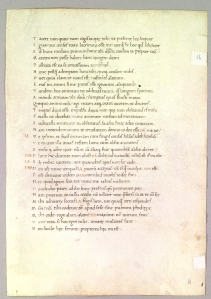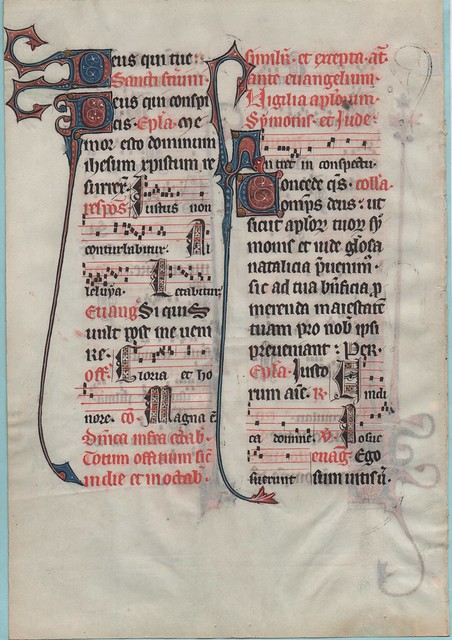As you might imagine, there are not a lot of medieval manuscripts in Vermont. I know of only two repositories: Middlebury College (which reported holdings of 15 leaves and one codex) and the University of Vermont in Burlington (which reported holdings of ten codices and 26 leaves, seven of which belong to the Robert Hull Fleming Museum). As we cross the Connecticut River, leaving New Hampshire for Vermont, let’s head north on I-89 towards Burlington to visit the University of Vermont on the shores of beautiful Lake Champlain.
The University of Vermont has owned some of these manuscripts since the early part of the twentieth century, as eight of them are recorded in Seymour de Ricci’s Census of Medieval and Renaissance Manuscripts in the United States and Canada (published in 1935). They’ve now been catalogued and digitized as part of the library’s Digital Initiatives Collection.

I’ve not looked as these images before, but I recognize at least two of the leaves as belonging to a very well-known manuscript, a copy of Terence’s works that was once owned by notorious book-breaker Otto F. Ege (more about him when we get to Ohio in a few weeks!):

Here’s another leaf from the same manuscript, part of the collection at Columbia University in NYC, for comparison: Rare Book and Manuscript Library, Med/Ren Frag. 004
The late great paleographer Albinia de la Mare attributed this beautiful humanistic bookhand to the expert scribe Giuliano di Antonio of Prato, Florence and believed it to have been written around 1460. This manuscript was still complete, its 103 leaves safely ensconced in the original binding of brown leather over wooden boards, when it was sold as lot 100 at Sotheby’s on May 28, 1934. It was bought at auction and made its way to Dawson’s Bookshop in Los Angeles; the next year, it was purchased by Otto Ege himself. It was still intact when it was described by Seymour de Ricci as Ege manuscript no. 65 in the Census of Manuscripts (II:1947). Ege dismantled the manuscript sometime after 1935 and scattered its leaves to the proverbial winds. Scott Gwara of the University of South Carolina tells me that these and other leaves were donated to the University of Vermont by Frank Teagle, a letterpress-printer who worked for Ege’s widow and who may have received at least some of these leaves as compensation for his work.
The Terence manuscript is discussed in Barbara Shailor’s seminal study of Otto Ege and in Gwara’s forthcoming Ege monograph. Ege is a character well-known to American bibliophiles, a self-proclaimed “biblioclast” active in Ohio in the 1930s and ’40s, a man whose socialist leanings (combined, ironically, with a bookdealer’s art-market savvy) trickled down even to his penchant for dismantling books and distributing/selling the resulting collections of individual leaves to small public libraries and colleges that couldn’t afford to acquire complete manuscripts. As a result of the work of scholars such as Virginia Brown, Barbara Shailor, Fred Porcheddu, and now Scott Gwara, ex-Ege leaves are becoming more and more well-known and recognizable (Melissa Conway and I have also recorded dozens of Ege leaves we’ve encountered in our travels). At least two dozen pages of the Terence manuscript have been identified in collections from Poughkeepsie to Boulder, although many more remain to be found before the entire manuscript can be digitally reconstructed.
In addition to the Terence leaves, I found this little creature lurking in the margins of a leaf in the Fleming Museum collection. Someone should tell the local cryptozoologists searching Lake Champlain for the sea monster known as “Champ” that they can find him swimming about in the Museum.






The University of Vermont’s Bailey/Howe Library has a beautifully clean website that’s simple to navigate and a great asset, I’m certain, to the campus using this modern institution. Their medieval manuscripts appear to be nicely cataloged with crisply rendered digital images. Would be nice if they had whole manuscripts up on line, but what I see is fabulous.
I love the marginal hybrid you featured, Lisa. Have you considered making him the mascot of your journey, or perhaps only the Northeast since you are sure to find others of his kind along the way.
What a wonderful note about this Terence manuscript! I would also add A .S.G. Edwards and Julia Boffey to those scholars who have worked on Ege (see their Medieval Manuscripts in the Norlin Library: A Summary Catalogue, Pegasus Press, 2002).
This is most probably another ex-Ege leaf: http://www.jamescumminsbookseller.com/pages/books/256215/marcus-tullius-cicero/manuscript-leaf-comprising-a-portion-of-ciceros-de-finibus-bonorum-et-malorum-liber-secundus
(see page 4 of your article Journal of the Rutgers University Libraries, Volume LX)
Sure seems like it’s a leaf of Ege’s Cicero: correct number of lines, the dimensions are right, the date and place of origin, and of course the text. Can you post a picture? Then we’d know for sure!
The recto side of the leaf can be seen here. The quality is not the best. The leaf number appears to be “38”.
http://checkthis.com/uov1
Definitely Ege’s Cicero! Very cool.
These leaves might also be of interest. All four leaves are from Ege’s collection:

http://www.flickr.com/photos/36735978@N05/4382524632/in/photolist-7FgzTw-8vyTu6-8vBVPQ
http://www.flickr.com/photos/36735978@N05/4929092537/in/photolist-8vyTu6-8vBVPQ
All important examples of well-known Ege leaves!
You are welcome.
Pingback: Manuscript Road Trip: Miami University (the one in Ohio, not the one in Florida!) | Manuscript Road Trip